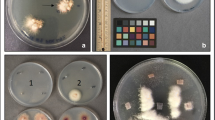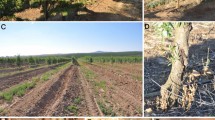Abstract
This study was designed to identify and compare the Fusarium species of the Gibberella fujikuroi complex on pearl millet (Pennisetum glaucum (L.) R. Br) and corn (Zea mays L.) crops grown in southern Georgia, and to determine their influence on potential fumonisin production. Pearl millet and corn samples were collected in Georgia in 1996, 1997 and 1998. Three percent of the pearl millet seeds had fungi similar to the Fusarium species of the G. fujikuroi species complex. One hundred and nineteen representative isolates visually similar to the G. fujikuroi species complex from pearl millet were paired with mating population A (Fusarium verticillioides (Sacc.) Nirenberg), mating population D (F. proliferatum (Matsushima) Nirenberg) and mating population F (F. thapsinum (Klittich, Leslie, Nelson and Marasas) tester strains. Successful crosses were obtained with 50.4%, 10.1% and 0.0% of these isolates with the A, D and F tester strains, while 39.5 of the isolates did not form perithecia with any tester strains. Two of the typical infertile isolates were characterized by DNA sequence comparisons and were identified as Fusarium pseudonygamai (Nirenberg and O’Donnell), which is the first known isolation of this species in the United States. Based on the pattern of cross-compatibility, conidiogenesis, colony characteristics and media pigmentation, a majority of the infertile isolates belong to this species. Fumonisins FB 1 and FB 2 were not detected in any of the 81 pearl millet samples analyzed. The species of the G. fujikuroi species complex were dominant in corn and were isolated from 84%, 74% and 65% of the seed in 1996, 1997 and 1998, respectively. Representative species of the G. fujikuroi species complex were isolated from 1996 to 1998 Georgia corn survey (162, 104 and 111 isolates, respectively) and tested for mating compatibility. The incidence of isolates belonging to mating population A (F. verticillioides) ranged from 70.2% to 89.5%. Corn survey samples were assayed for fumonisins, and 63% to 91% of the 1996, 1997 and 1998 samples were contaminated. The total amount of fumonisins in the corn samples ranged from 0.6 to 33.3 μg/g.
Similar content being viewed by others
References
JF Leslie CAS Pearson PE Nelson TA Toussoun (1990) ArticleTitleFusarium spp. from corn, sorghum, and soybean fields in the central and eastern United States Phytopathology 80 IssueID4 343–350
PE Nelson TA Toussoun WFO. Marasas (1983) Fusarium Species – An Illustrated Manual for Identification The Pennsylvania State University Press University Park, PA
K O’Donnell E Cigelnik HI Nirenberg (1998) ArticleTitleMolecular systematics and phylogeography of the Gibberella fujikuroi species complex Mycologia 90 IssueID3 465–493 Occurrence Handle1:CAS:528:DyaK1cXktFSgtrY%3D
HI Nirenberg K O’Donnell (1998) ArticleTitleNew Fusariumspecies and combinations within the Gibberella fujikuroi species complex Mycologia 90 IssueID3 434–458
K O’Donnell HI Nirenberg T Aoki A Cigelnik E. (2000) ArticleTitlemultigene phylogeny of the Gibberella fujikuroispecies complex: detection of additional phylogenetically distinct species Mycoscience 41 IssueID1 61–78 Occurrence Handle1:CAS:528:DC%2BD3cXltFWiu74%3D
MC. Shurtleff (1980) Compendium of Corn Diseases. 2nd ed St. Paul, Minnesota American Phytopathological Society
EA Sobek GP. Munkvold (1999) ArticleTitleEuropean corn borer (Lepidoptera: Pyralidae) larvae as vectors of Fusarium moniliforme, causing kernel rot and symptomless infection of maize kernels J Econ Entomol 92 IssueID3 503–509
Miller JD. Aspects of the ecology of fusarium toxins in cereals. Adv Exp Med Biol 504: 19–27.
GS Shephard PG Thiel S Stockenström EW Sydenham (1996) ArticleTitleWorldwide survey of fumonisin contamination of corn and corn-based products J AOAC Int 79 IssueID3 671–687 Occurrence Handle1:CAS:528:DyaK28Xjt1alsbg%3D Occurrence Handle8634537
A. Visconti (1996) Fumonisins in maize genotypes grown in various geographic areas LS Jackson WJ DeVries LB Bullerman (Eds) Fumonisins in Food Plenum Press New York 193–204
A Visconti M Pascale MB Doko (1996) Fumonisins in Europe. Production by Fusariumisolated from cereals and occurrence in maize and maize products intended for human and animal consumption G Marengo F Pastoni (Eds) The European Union’s innovative policy against food-trasmitted disease, EUR 16414 EN ECSC-EC-EAEC Brussels, Luxembourg 162–174
Z Jurjevic M Solfrizzo G Avantaggiato A Visconti (1999) ArticleTitleOchratoxin A and fumonisins (B1 and B2) in maize from Balkan nephropathy endemic and non-endemic areas of Croatia Mycotoxin Res 15 67–80 Occurrence Handle1:CAS:528:DC%2BD3cXhs1alu7Y%3D Occurrence Handle10.1007/BF02945217
WFO Marasas (1995) ArticleTitleFumonisins: their implications for human and animal health Nat Toxins 3 193–198 Occurrence Handle1:CAS:528:DyaK2MXosl2nur0%3D Occurrence Handle7582616
NTP Technical Report on the Toxicology and Carcinogenesis Studies of Fumonisin B1 (CAS No. 116355-83-0) in F344/N Rats and B63F1 Mice (feed studies), NTP TR 496; NIH Publication No. 01-3955. Washington: US Department of Health and Human Services, 2001: 15 pp.
O Davis (1968) ArticleTitleThe origin of agriculture in West Africa Curr Anthropol 9 479–482 Occurrence Handle10.1086/200945
NBN Onyike PE Nelson WFO Marasas (1991) ArticleTitleFusarium species associated with millet grain from Nigeria, Lesotho, and Zimbabwe Mycologia 83 IssueID6 708–712
CJR Klittich JF Leslie (1988) ArticleTitleNitrate reduction mutants of Fusarium moniliforme (Gibberella fujikuroi) Genetics 118 417–423 Occurrence Handle1:CAS:528:DyaL1cXhvVenu7s%3D Occurrence Handle17246415
CJR Klittich JF Leslie (1992) ArticleTitleIdentification of a second mating population within the Fusarium moniliforme anamorph of Gibberella fujikuroi Mycologia 84 IssueID4 541–547
DM Geiser JH Juba B Wang SN Jeffers (2001) ArticleTitleFusarium hostae sp. nov., a relative of F. redolens with a Gibberella teleomorph Mycologia 93 IssueID4 670–678
DL Swofford (2002) PAUP*: Phylogenetic Analysis Using Parsimony (and Other Methods) 4.0 Beta (CD-ROM) Sinauer and Associates Sunderland Mass
K Singh JC Frisvad U Thrane SB Mathur (1991) An Illustrated Manual on Identification of Some Seed-borne Aspergilli, Fusaria, Penicillia and Their Mycotoxins Danish Government, Institute of Seed Pathology for Developing Countries Hellerup Denmark 133
A Visconti MB Doko (1994) ArticleTitleSurvey of fumonisins production by Fusarium isolated from cereals in Europe J AOAC Int 77 IssueID3 546–550 Occurrence Handle1:CAS:528:DyaK2cXjtFyqtLk%3D Occurrence Handle8199488
Visconti A, Pascale M. Improvement of fumonisin extraction from maize samples. EURO-ANALYSIS IX – European Conference on Analytic Chemistry, Bologna (Italy), September 1–7, 1996: 152 (Abstract).
JP Wilson WW Hanna DM Wilson RW Beaver HH. Casper (1993) ArticleTitleFungal and mycotoxin contamination of pearl millet grain in response to environmental conditions in Georgia Plant Dis 77 IssueID2 121–124 Occurrence Handle1:CAS:528:DyaK3sXkvFCjsL8%3D Occurrence Handle10.1094/PD-77-0121
JP Wilson HH Casper DM Wilson (1995) ArticleTitleEffect of delayed harvest on contamination of pearl millet grain with mycotoxin-producing fungi and mycotoxins Mycopathologia 132 IssueID1 27–30 Occurrence Handle10.1007/BF01138600
J Fotso JF Leslie JS Smith (2002) ArticleTitleProduction of beauvericin, moniliformin, fusaproliferin, and fumonisins B1, B2, and B3 by fifteen ex-type strains of Fusarium species Appl Environ Microbiol 68 IssueID10 5195–5197 Occurrence Handle10.1128/AEM.68.10.5195-5197.2002 Occurrence Handle1:CAS:528:DC%2BD38XnvFCks7o%3D Occurrence Handle12324376
CW Bacon JW Williamson (1992) ArticleTitleInteractions of Fusarium moniliforme, its metabolites and bacteria with corn Mycopathologia 117 IssueID1–2 65–71 Occurrence Handle10.1007/BF00497280 Occurrence Handle1:CAS:528:DyaK38Xkt1eiu7c%3D
W Gerlach H Nirenberg (1982) The genus Fusarium– a pictorial atlas Mitteilungen aus der Biologischen Bundesanst fur Land- und Forstwirtschaft Berlin-Dahlem 406
Author information
Authors and Affiliations
Corresponding author
Rights and permissions
About this article
Cite this article
Jurjevic, Z., Wilson, D.M., Wilson, J.P. et al. Fusarium species of the Gibberella fujikuroi complex and fumonisin contamination of pearl millet and corn in Georgia, USA. Mycopathologia 159, 401–406 (2005). https://doi.org/10.1007/s11046-004-1050-2
Received:
Accepted:
Issue Date:
DOI: https://doi.org/10.1007/s11046-004-1050-2




